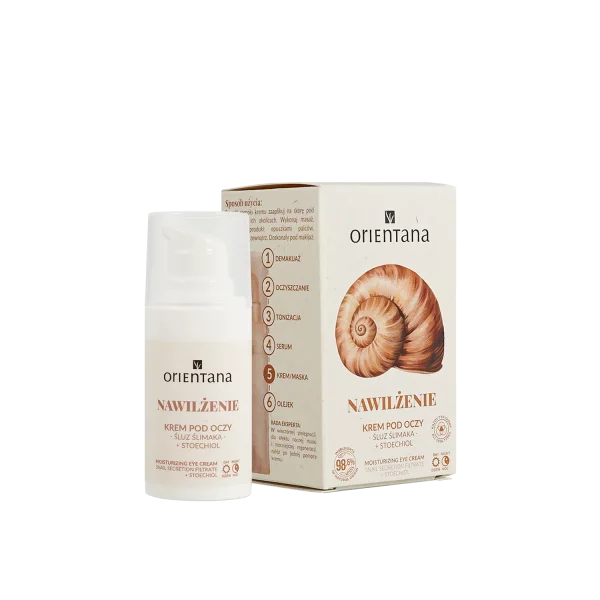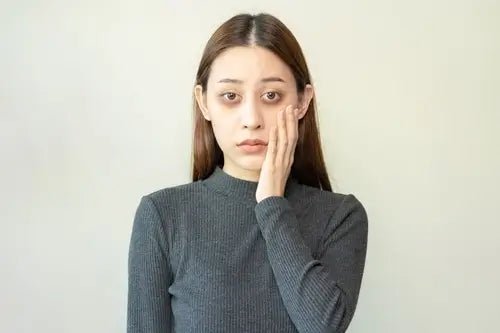Dark circles are a common cosmetic problem that affects people of all ages, genders, and skin types. Often seen as a sign of fatigue or aging, dark circles around the eyes can have much deeper causes, from genetic predisposition to more serious health issues.
Studies indicate that dark circles are not usually a medical concern, but for aesthetic reasons, many people seek effective methods to reduce them. In this blog post, we present a comprehensive analysis of the causes of dark circles and effective strategies to combat them, from simple home remedies to advanced cosmetic procedures.

dark circles under the eyes - Definition and characteristics
Dark circles are a darkened area of skin directly under the eyes that can range from blue and purple to brown and black, depending on the natural skin color of the person. The skin in this area is extremely delicate, thin, and has a shallow blood supply, and is virtually devoid of fat tissue, making it more susceptible to changes and visible discoloration. Dark circles often make a person look more tired or older than they actually are, which can affect how others and themselves perceive their appearance.
Occurrence and risk groups
Anyone can get dark circles, but research suggests they are more common in older people, those with a family history of the condition, and those with darker skin tones. This cosmetic defect is not linked to a specific skin type, although the visibility of dark circles can vary depending on individual characteristics, such as skin thickness or blood vessel layout. It’s worth noting that the tendency to develop dark circles often has a genetic component, meaning that some people may be more susceptible to them regardless of their lifestyle or skincare routine.
Differences in appearance and perception
The appearance of dark circles under the eyes can vary significantly from person to person. In some, they manifest as subtle bruising, in others as deep, dark circles resembling bruises. It is worth distinguishing dark circles under the eyes from other eye problems, such as swelling or tear troughs, although they often occur at the same time, intensifying the unfavorable visual effect.
The perception of dark circles under the eyes as an aesthetic problem is also strongly culturally determined - in some societies they may be considered a characteristic feature, while in others, such as ours, they constitute a defect that needs to be masked.
Causes of dark circles under the eyes
Dark circles under the eyes can appear for many reasons, and understanding their cause is key to effective treatment. The most common cause is the body's natural aging process, which causes the skin under the eyes to thin and lose elasticity, making blood vessels more visible. This process is inevitable, but can be accelerated by poor habits and lifestyle.
Genetic and constitutional factors
The tendency to have dark circles under the eyes is often hereditary. People whose parents or grandparents struggled with this problem are more likely to have it.
Genetics influence the distribution of subcutaneous fat and the network of blood vessels, which directly translates into the visibility of dark circles. Some people are born with naturally thinner skin under the eyes, which makes the blood vessels more visible, creating the characteristic dark circles. This is a constitutional trait that can be difficult to completely eliminate.
Fatigue, stress and sleep deprivation
Lack of sleep is one of the most common causes of dark circles under the eyes. Sleep deprivation leads to lymph stagnation around the eyes, which results in the appearance of dark circles.
Stress also plays a significant role in this process. Stress mechanisms lead to hormonal changes that can affect the color and texture of the skin, making dark circles more visible. Chronic stress can also disrupt the quality of sleep, creating a vicious cycle that deepens the problem.
Skin Aging and Natural Processes
As we age, our skin loses elasticity due to a decrease in collagen and elastin production, making it thinner and more transparent. As a result, blood vessels under the eyes become more visible, creating a characteristic blue tint.
Additionally, the volume of fatty tissue around the eye decreases, which can lead to the formation of so-called tear troughs, deepening the impression of shadows. These natural aging processes are inevitable, but can be slowed down by proper care and a healthy lifestyle.
External factors and lifestyle
Lifestyle has a huge impact on the appearance of the skin under the eyes. Smoking leads to so-called smoker's skin, which is characterized by a gray, bluish tint under the eyes.
Excessive alcohol and coffee consumption can also contribute to the problem. Unprotected sun exposure causes premature skin aging, which accentuates dark circles under the eyes. Inappropriate care of this sensitive area, such as aggressive eye rubbing or using the wrong cosmetics, can further aggravate the problem.
Allergies and health problems
Dark circles under the eyes can be a symptom of allergies to cosmetic ingredients, chemicals, animal hair, dust, mites or even some foods. Allergic reactions lead to inflammation, which can manifest as darkening of the skin under the eyes.
In some cases, dark circles can indicate more serious health problems, such as hypothyroidism or anemia. Hypothyroidism is characterized by low thyroid hormone levels, which can cause water retention and puffiness, which can increase the appearance of dark circles under the eyes.
Prevention and daily habits
Preventing dark circles under the eyes is a process that requires a systematic and comprehensive approach to health and care. Introducing the right habits can significantly improve the appearance of the skin around the eyes and prevent the problem from getting worse. The basis of prevention is to provide the body with an adequate amount of rest and regeneration, which directly translates into the condition of the skin under the eyes.
The right amount of sleep and sleeping position
Sleep is a time when the body regenerates and the skin regains its vitality. Experts recommend at least seven hours of sleep every night to prevent dark circles under the eyes. The quality of sleep is just as important as the length of sleep - it is worth ensuring comfortable conditions, eliminating noise and the right temperature in the bedroom. Sleeping position also matters - elevating the head by using an additional pillow can help reduce lymph stagnation and prevent swelling under the eyes. This is especially important for people who wake up with puffy eyes.
A healthy diet and adequate hydration
A diet rich in antioxidants, vitamins and minerals supports skin health and can prevent dark circles under the eyes. Foods rich in vitamin K (spinach, broccoli), vitamin C (citrus fruits) and iron (red meat, legumes) are especially important.
Proper hydration is key to maintaining skin elasticity - it is worth drinking at least 1.5-2 liters of water a day, avoiding excessive alcohol and caffeine consumption, which can contribute to dehydration and deepen dark circles under the eyes.
Protection against external factors
Protecting your skin from the harmful effects of UV rays is essential for preventing dark circles under the eyes. Prolonged exposure to the sun without proper protection leads to premature skin aging and deepening of dark circles. It is worth using a cream with SPF every day, even on cloudy days, and also wearing sunglasses, which additionally protect the delicate skin around the eyes. Equally important is protection from environmental pollution, which can accelerate the skin aging process.
Stress Reduction and Relaxation Techniques
Chronic stress can significantly impact the appearance of your skin, including dark circles under your eyes. Adding relaxation techniques like meditation, yoga, or deep breathing to your daily routine can help reduce stress and improve the quality of your sleep. Regular exercise not only helps reduce stress, but also improves blood and lymph circulation, which can reduce fluid buildup under your eyes and improve the appearance of the area.
Home remedies for dark circles under the eyes
Before we reach for professional methods to combat dark circles under the eyes, it is worth trying home remedies, which often prove effective, especially for less severe problems. These natural methods can bring relief and improve the appearance of the skin under the eyes, especially when dark circles are the result of fatigue or lack of sleep. Home remedies are safe, economical and easily accessible.
Cold compresses and wraps
Cold compresses are one of the simplest and most effective home remedies for dark circles under the eyes. Cold causes blood vessels to constrict, which reduces the visibility of dark circles and reduces swelling. You can use chilled cucumber slices, tea bags, chilled spoons or potato slice compresses. The compress should be applied to closed eyelids for about 10-15 minutes. Regularly used cold compresses can significantly improve the appearance of the skin under the eyes, especially when dark circles are caused by fatigue or allergies.
Massage and lymphatic drainage
A gentle massage of the eye area can improve blood and lymph circulation, which helps reduce fluid retention and dark circles. The massage is best performed with fingertips, gently moving them from the inner corner of the eye towards the temples. It is worth enriching the massage with elements of lymphatic drainage, which is particularly effective in removing excess fluid from the eye area. Regularly performing such a massage, preferably in the morning and evening, can bring visible results after just a few weeks.
Natural ingredients and masks
Many natural ingredients have brightening and anti-inflammatory properties that can help combat dark circles under the eyes. Aloe, honey, yogurt, and coconut oil are products that can be successfully used as masks or gently patted into the skin under the eyes. Aloe is particularly effective, as it has moisturizing and anti-inflammatory properties. It is best to use masks made of natural ingredients 2-3 times a week, leaving them on the skin for about 15-20 minutes, and then gently washing them off with lukewarm water.
When home remedies are not enough, it is worth reaching for professional cosmetics designed specifically to combat dark circles under the eyes. The market offers a wide selection of products that, thanks to advanced formulas and active ingredients, can significantly improve the appearance of the skin under the eyes. When choosing professional cosmetics, it is worth paying attention to their composition and action aimed at a specific problem.

Eye creams and serums
Creams and serums dedicated to the eye area contain concentrated active ingredients that work on specific problems of this sensitive area. Products for dark circles under the eyes often contain hyaluronic acid or peptides, which stimulate collagen production, brighten the skin and improve its firmness. Serums with peptides and EGF are a good solution for dark circles under the eyes. One of the best eye creams that eliminate dark circles under the eyes is Eye Cream with Snail Slime. When choosing a cream, it is worth matching it to the cause of the dark circles - if they are the result of fatigue, products with caffeine will work best, which stimulates microcirculation, while for dark circles resulting from skin aging, creams with peptides and retinoids will be more effective.
Active ingredients and their effects
The most common active ingredients in anti-dark circles cosmetics are: vitamin C (brightening and antioxidant), retinol (stimulates cell renewal), caffeine (improves microcirculation), hyaluronic acid (moisturizes and fills), niacinamide (lightens discolorations) and peptides (stimulate collagen production). Each of these ingredients works in a slightly different way, so the best results are achieved by using cosmetics containing their combination. It is worth remembering that some ingredients, such as retinol, may initially cause irritation, so they should be introduced gradually.
Concealers and concealing makeup
For an immediate effect of masking dark circles under the eyes, it is worth reaching for specialist concealers. The best results are provided by concealers in the opposite color to the shade of the shadows - yellow or peach for dark circles, green for redness. Concealers should have a light, creamy consistency that will not emphasize wrinkles or dry skin. When applying concealer, it is worth using a small amount of the product and patting it in with your fingertips or a damp sponge, avoiding excessively burdening the delicate skin under the eyes.
Cosmetic and medical treatments
In the case of persistent dark circles under the eyes that do not respond to home remedies and cosmetics, it is worth considering professional cosmetic or medical treatments. Modern cosmetology and aesthetic medicine offer a wide range of procedures that can effectively reduce dark circles under the eyes, even those of genetic origin or related to the aging process. Choosing the right treatment should be preceded by a consultation with a specialist.
Mesotherapy and moisturizing treatments
Mesotherapy is a procedure involving the introduction of active substances directly into the skin using microinjections. In the case of dark circles under the eyes, cocktails containing hyaluronic acid, vitamins, antioxidants and peptides are used, which moisturize, brighten and regenerate the skin. The procedure gives the effect of rested, radiant skin and is particularly effective for dark circles associated with dehydration and loss of elasticity. Another option is moisturizing treatments, such as hydropeeling or oxygen infusion, which intensively hydrate the skin and improve its color.
Laser and IPL treatments
Fractional laser or IPL (Intense Pulsed Light) treatments can significantly improve the condition of the skin under the eyes. They stimulate collagen production, improve skin density and reduce the visibility of blood vessels, which are often the cause of dark circles. These treatments are particularly effective for dark circles caused by hyperpigmentation or shallow blood vessels. They require a series of sessions and the effects are permanent, although they may require periodic refreshing as the aging process progresses.
Fillers and aesthetic medicine treatments
In the case of dark circles under the eyes caused by loss of volume and the formation of the so-called tear trough, hyaluronic acid fillers can be an effective solution. The procedure involves injecting a small amount of the preparation, which fills the sunken areas and creates the effect of "illuminating" the skin from the inside. Another option is treatments using your own platelet-rich plasma (PRP), which stimulates skin regeneration and improves its density. Aesthetic medicine treatments should only be performed by qualified specialists, due to the delicacy of the treatment area.
When to consult a doctor
Although dark circles under the eyes are most often a cosmetic problem, in some cases they can signal more serious health problems. It is worth consulting a doctor if dark circles under the eyes appear suddenly, are very intense, or are accompanied by other disturbing symptoms. A specialist will help identify the cause of the problem and suggest the most effective solution.
Alarming symptoms and potential diseases
If dark circles are accompanied by symptoms such as chronic fatigue, weight loss, difficulty concentrating, or sleep disorders, this may indicate health problems that require medical intervention. Dark circles under the eyes may be a symptom of anemia, hypothyroidism, allergies, chronic inflammation, or metabolic disorders.
Dark circles under the eyes that appear suddenly and are asymmetrical are particularly worrying - they may indicate circulatory problems or inflammation. In such cases, it is necessary to consult a general practitioner, who will order appropriate diagnostic tests.
Appropriate specialists and diagnostics
Depending on the suspected cause of dark circles, the patient may be referred to different specialists. A dermatologist will help with skin problems, an allergist if allergic reactions are suspected, an endocrinologist if hormonal disorders are suspected, and an ophthalmologist if the dark circles are related to eye problems. Basic diagnostics include blood tests (blood count, thyroid hormones, iron levels) that can rule out or confirm a medical cause. In some cases, more advanced tests, such as allergy tests or imaging studies, may be necessary.
Dark circles are a common problem that can have a variety of causes, from genetic predisposition to serious health problems. The key to effectively combating dark circles is to identify their cause and choose the right methods to counteract them. In most cases, a comprehensive approach, combining a healthy lifestyle, proper care and, if necessary, professional treatments, brings the best results.
First of all, it is worth taking care of the right amount of sleep (at least 7 hours), a healthy diet rich in antioxidants and proper hydration of the body. Equally important is sun protection and the use of cosmetics adapted to the sensitive skin under the eyes. In the case of persistent dark circles that do not respond to home remedies, it is worth consulting a specialist who will suggest professional solutions, such as mesotherapy, laser treatments or fillers. Remember that the results are not immediate - both home remedies and professional treatments require systematic use and patience.






